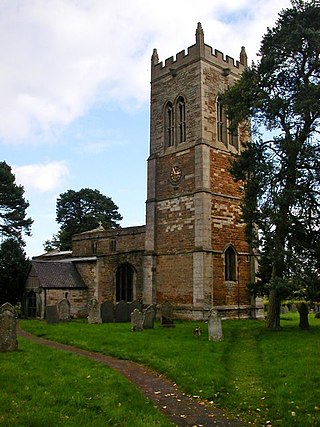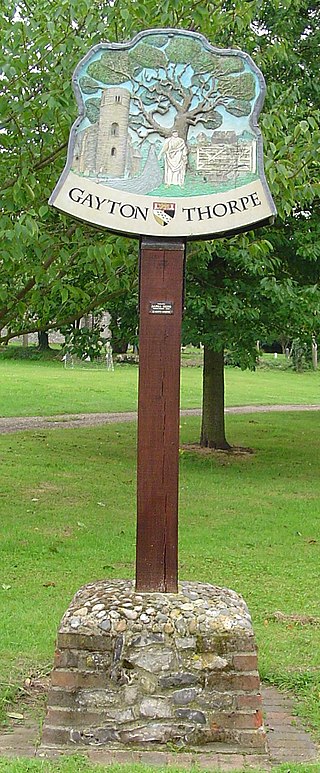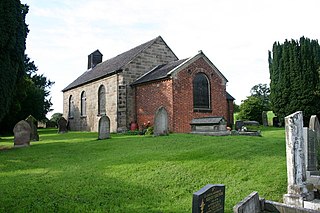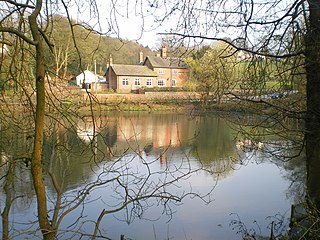
Marston Trussell is a village and civil parish in West Northamptonshire in England. Marston Trussell was first recorded as 'Mersitone', meaning marsh settlement. The parish includes Thorpe Lubenham. At the time of the 2001 census, its population was 163 people, reducing slightly to 157 at the 2011 census but including Lubenham.

Beaumont Leys is a suburb and electoral ward in north-western Leicester, in the Leicester district, in the ceremonial county of Leicestershire, England. The population of the ward at the 2011 census was 16,480. Locally, Beaumont Leys is usually used in reference to the large housing estate, built within the administrative division, centred on Strasbourg Drive.

Thurnby is a village and former civil parish, now in the parish of Thurnby and Bushby, in the Harborough district, in the county of Leicestershire, England. It is just east of Leicester's city boundaries.

New Parks is residential suburb of the city of Leicester, in the Leicester district, in the ceremonial county of Leicestershire, England. It was also an electoral ward of the City of Leicester whose population at the 2011 Census was 17,128.
Oxendon was a rural district in Northamptonshire, England from 1894 to 1935.

Little Bowden is an area on the edge of Market Harborough and former civil parish, now in the unparished area of Market Harborough, in the Harborough district, in the county of Leicestershire, England. As a village it was formerly part of Northamptonshire. The River Jordan runs through part of the area. Now, it's been integrated into Market Harborough and is fully part of the town using the town's address of 'Market Harborough'. In 1921 the parish had a population of 2768. On 1 April 1927 the parish was abolished and merged with Market Harborough.

Gayton Thorpe is a village and former civil parish, now in the parish of Gayton, in the King's Lynn and West Norfolk district, in the county of Norfolk, England. In 1931 the parish had a population of 136.

Thorpe le Street is a hamlet and former civil parish, now in the parish of Hayton, in the East Riding of Yorkshire, England. It is situated approximately 3.5 miles (5.6 km) south-east of the market town of Pocklington and 3 miles (4.8 km) north-west of the market town of Market Weighton. It lies to the south of the A1079 road. In 1931 the parish had a population of 28. On 1 April 1935 the parish was abolished and merged with Hayton. The Roman Road known as Cade's Roadis thought likely to have passed through it, which would explain "-le-Street".
Brackenthwaite is a settlement and former civil parish in Lake District of England. It is situated some 6 miles (9.7 km) south of Cockermouth in the county of Cumbria. It should not be confused with the identically named settlement of Brackenthwaite that is situated some 3 miles (4.8 km) south-east of the town of Wigton in the same county. In 1931 the parish had a population of 89.

West Northamptonshire is a unitary authority area covering part of the ceremonial county of Northamptonshire, England, created in 2021. By far the largest settlement in West Northamptonshire is the county town of Northampton. Its other significant towns are Daventry, Brackley and Towcester; the rest of the area is predominantly agricultural villages though it has many lakes and small woodlands and is passed through by the West Coast Main Line and the M1 and M40 motorways, thus hosting a relatively high number of hospitality attractions as well as distribution centres as these are key English transport routes. Close to these is the leisure-use Grand Union Canal.

Broomsthorpe is a place and former civil parish, now in the parish of East Rudham, in the King's Lynn and West Norfolk district, in the English county of Norfolk. It is the site of a deserted medieval village with scheduled ancient monument status to the south of Coxford. This may be the location of the village of Sengham or possibly Tattersett St Andrew. It lies south-east of the site of Coxford Priory in the parish of Tattersett. In 1931 the parish had a population of 22. Broomsthorpe was an extra-parochial area, in 1858 it became a separate civil parish, on 1 April 1935 the parish was abolished and merged with East Rudham.

Bushby is a village and former civil parish, now in the parish of Thurnby and Bushby, in the Harborough district, in Leicestershire, England. In 1931 the parish had a population of 336.

Boundary is a large hamlet and as The Boundary a former civil parish, in South Derbyshire situated between the towns of Swadlincote and Ashby-de-la-Zouch on the A511 route. It is west of the village of Smisby and forms part of the county border with Leicestershire, hence its name. Residences on the north side of the A511 lie in Derbyshire and those on the south side lie within Leicestershire. The hamlet now falls within the civil parishes of Smisby, Derbyshire and Ashby-de-la-Zouch, Leicestershire. In 1931 the parish had a population of 87.
Pilsgate is a hamlet and former civil parish, now in the parish of Barnack, in the Peterborough district, in the ceremonial county of Cambridgeshire, England. Pilsgate is close to the county boundary and 3 miles (5 km) south-east of Stamford, Lincolnshire. In 1881 the parish had a population of 125.

Langley Priory is a former Benedictine nunnery in the civil parish of Isley cum Langley, in the North West Leicestershire district, in the county of Leicestershire, England. It is located around a mile and a half south of East Midlands Airport; around a mile from the village of Diseworth.

Blackfriars Leicester is a former Dominican Friary in Leicester, England.

St Nicholas's Church is an Anglican Church and the parish church of Marston Trussell. It is a Grade I listed building and stands on the south side of Lubenham Road at the eastern edge of the village.

Marston is a village and civil parish 12 miles (19 km) south of Stoke-on-Trent, in the Stafford district, in the county of Staffordshire, England. In 2011 the parish had a population of 158. The parish touches Creswell, Hopton and Coton, Salt and Enson, Sandon and Burston, Stone Rural and Whitgreave.

Thorpe Underwood is a settlement and a civil parish about 10 miles (16 km) north of York, in the Harrogate district, in the county of North Yorkshire, England. In 2011 the parish had a population of 793. The parish touches Aldwark, Green Hammerton, Kirby Hall, Linton-on-Ouse, Little Ouseburn, Nun Monkton and Whixley. Thorpe Underwoods shares a parish council with Little Ouseburn and Kirby Hall called "Little Ouseburn Grouped Parish Council".

Stone Rural is a civil parish in the Stafford district, in the county of Staffordshire, England. The parish includes the settlements of Aston-By-Stone, Burybank, Cotwalton, Knenhall, Meaford, Moddershall, Oulton, Oulton Grange and Oulton Heath. In 2011 the parish had a population of 1652. The parish touches Barlaston, Chebsey, Fulford, Hilderstone, Marston, Sandon and Burston, Stone, Swynnerton, Whitgreave and Yarnfield and Cold Meece. There are 39 listed buildings in Stone Rural. The council office is in Moddershall.


















